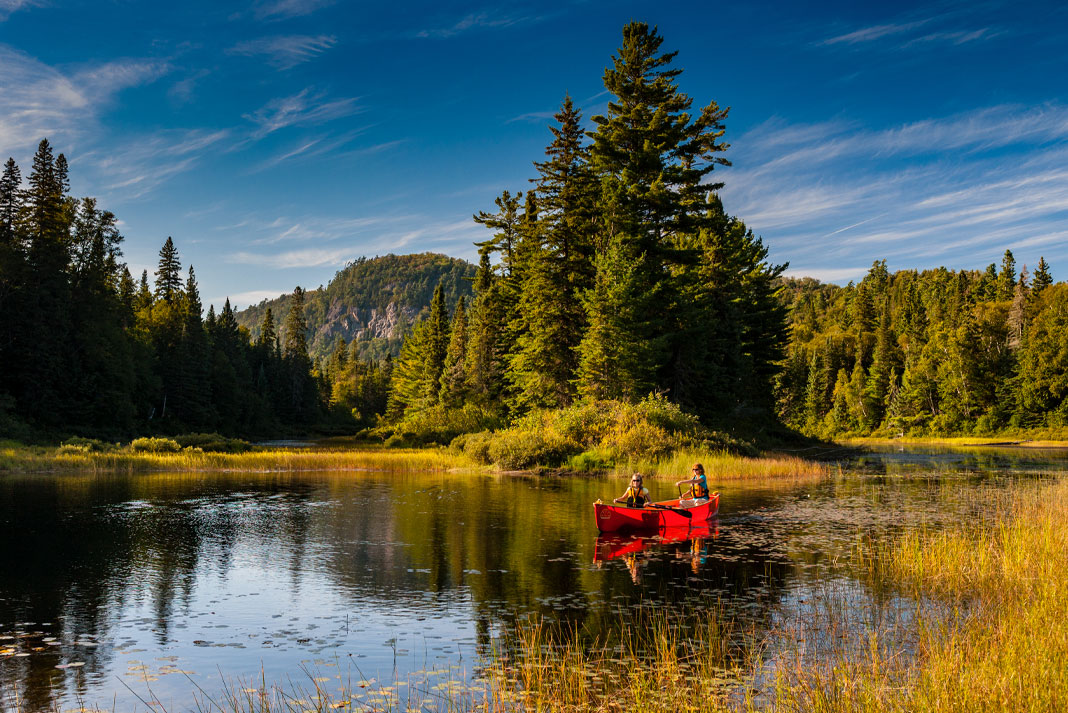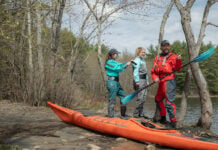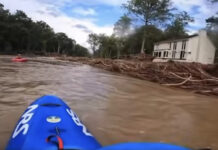Travel anywhere in North America and you will notice the shape and color of canoes shift with the landscape. The reasons why are not always logical.
On a recent two-week trip in northern Ontario’s Quetico Provincial Park, I was hard-pressed to spot a single canoe not plain Kevlar. All the tripping canoes I paddled by seemed to come from the same marathon-racing-inspired mold—lengthy, ultralight and beige. It wasn’t until well into my 18-hour drive home I noticed canoes with color and rocker gracing roof racks of passing vehicles.
I had lots of time to ponder why.
The canoe is of indigenous origin, and it’s easy to understand how the first designs would have evolved to fit local needs. “All the performance lines, whether it’s tumblehome, extreme rocker, straight keel, V, flare sides—we see those also in birchbark and other indigenous watercraft,” says Jeremy Ward, curator at the Canadian Canoe Museum.
Less obvious is why, in the age of industrial manufacturing and intermodal shipping, regional differences persist. While sea kayakers globally race to embrace the latest British, Danish or Swedish designs, and SUP racers upgrade to keep up with ever-narrower boards, canoeists stubbornly stick with local formulas that have worked for decades.
Bill Kueper, vice president of Minnesota-based Wenonah Canoe, which claims to build two-thirds of the world’s Kevlar canoes, sees the sales data supporting canoeing’s distinct regional trends. “We have minimal rockered boats going into the Boundary Waters. We make an identical reproduction of the Chestnut Prospector—the majority of those sales go to the U.K. and Australia. But forget about them in the U.S.”
Venture east and he says you will find 16-foot and shorter canoes popular for the meandering rivers of the Northern Forest Canoe Trail. Inexpensive plastic hulls are favored in the South where portaging is a rarity. The short, light pack canoes of the Adirondacks are perfect for hopping from pond to pond.
Journey west from the Adirondacks or southern Ontario into Wenonah’s homeland of Minnesota, and the tradition of wilderness canoe marathon racing, like the historic Ely-Atikokan Canoe Race, influences tripping canoes to be longer, lighter and less rockered. They also tend to have bucket-style seats on aluminum rails to favor sitting in the middle of the canoe and switching sides with a bent shaft paddle instead of J-stroking.

To simplify the geographical fault lines, Bear Paulsen of Minnesota’s Northstar Canoes suggests a divide somewhere around Madison, Wisconsin. “Once you go east from there, all the boats are short from our perspective,” he says. Everything to the west is 17 feet long or more.
Sales manager Wayne Docking of Souris River Canoes in Atikokan, Ontario, confirms this length distinction. “People in the southern part of the province often opt for a 14- or 15-foot canoe. In this part of the country, 16-footers are the minimum.”
In explaining why this difference persists, however, opinions differ. Paulsen posits, “The combination of long boats and ultralight grew together. If you are going to portage an 18-foot boat, it better well be lightweight.” It’s also possible the aging and, ahem, “expanding girth” of the population is prompting the demand for lighter canoes to compensate for reduced fitness, he muses.
According to Kueper, canoes in the Boundary Waters need to be faster because people are taking shorter trips, and the competition for campsites close to access points is driving the race to get deeper into the wilderness in less time. Both Kueper and Paulsen confirm paddlers in the Boundary Waters favor flatwater-specific canoes for their big lakes while those further east paddle a wider variety of conditions, including smaller lakes and rivers.
These regional differences don’t make the canoe industry so different from other outdoor industries, according to Kueper. Companies sell bikes or skis for different terrains and conditions—narrow carving skis for icy eastern slopes and mid-fats for smearing buttery arcs in western pow.
“It’s really about having the right tool for the job. Trail running would have a different shoe than marathon running. The modern canoe has been around for 100-plus years, but the refinement is to address a different situation in a different location on a scale to make it marketable,” says Kueper.
Whatever the explanation, builders’ assessments of regional “needs” too conveniently match the types of canoes they build for these reasons to be entirely practical. Wenonah thinks speed is critical; Atikokan-based Souris River says canoes need to be “kickass” tough. The real reasons may be more cultural than practical.
It’s probably no coincidence Mike Chichanowski, the founder of Wenonah, which is undoubtedly the most influential builder in the Midwest, started out as a canoe racer and set the aesthetics of speed as the standard by which generations of locals have judged their canoes.
There’s no reason why a flatwater canoeist in Algonquin Park should be any less interested in speed than one in Quetico, unless perhaps they took their influence more from artists than athletes. Which is probably why everyone in my part of the country seems to favor red canoes—much to the frustration of Hugh Stewart, founder of Quebec-based wood-canvas builder Headwaters Canoes. Red is a harder paint color to work with on canvas, he says.
“The Group of Seven always used red canoes,” says Stewart, as did the iconic Ontario canoeist, painter and filmmaker Bill Mason: “[Bill’s daughter] Becky Mason says until she was 15 she thought every canoe was red.” Such differences harken to traditions preexisting the Internet’s influence or the rationale of industrial manufacturing. People base their idea of a canoe on what they see around them.
“The Midwest has got its own kind of outdoor culture,” says Stewart. “You go to the outdoor books section in a bookstore and you’ve never heard of half the authors. And the people in Maine, when they build a wood canoe like ours, they still put shellac on the bottom instead of paint.”
Headwaters is just one of hundreds of small shops meeting the demand for local needs. Even for manufacturers like Souris River and Wenonah who ship globally, regional distinctions aren’t going away.
“We’ve been a canoe company now for 52 years and we’re not any closer to the universal answer,” says Kueper. “We’ve done a good job making it difficult. We’ve got a lot of models. Every year we sit down and talk about eliminating something, and we can never come to a consensus because we find some part of the world where it’s needed.”
For now, canoeists can be proud to have canoes atop their cars that somehow match their license plates. And perhaps, when traveling, have an incentive to embrace local traditions and rent, or else just paddle their own canoes—literally and figuratively—at the risk of sticking out from the crowd.
I spy with my little eye a red canoe. Must be the Northeast. | Featured photo: Gary McGuffin








